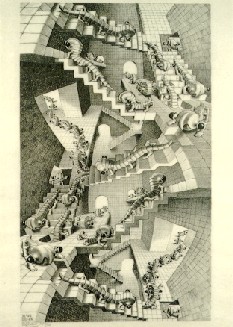

|
Now comes a further development of the concept of relativity. A playful
element has been introduced, glide reflexion. Roughly the whole of the top
half of the print is the mirror image of the bottom half. The topmost flight of steps, down which a curl-up is crawling from left to right, is reflected twice
over, once in the middle and then again in the lower part. On the stairs in the
top right hand corner, the distinction between ascending and descending has been
eliminated, for two rows of animals are moving side by side, yet one row is
going up and the other down.
An exquisitely complex print, the mathematical print grid of which can be
found in the book
For fun we are including an English translation of the text which Escher
wrote to accompany the original print:
The Pedalternorotandomovens Centroculatus Articulosus was created
(generatiospontanea!) out of dissatisfaction with the fact that in nature
there are no wheel-shaped creatures which are able to move by rolling. The
creature shown here, popularly known as a 'curl-up' is an attempt to fulfill
this deeply felt need. Its biological characteristics are still uncertain: is
it a mammal, a reptile or an insect? It has an elongated body consisting of
horny articulated plates and three pairs of legs, which end in feet similar to
the human foot. In the middle of the fat, round head, which has a sharply curved parrot beak, there are two protruding eyes, set on stalks and sticking out
from either side of the head. When it is stretched out, the creature is able
to move over any substratum slowly and thoughtfully, using its six legs (if
need be, it can climb up or go down steep stairs, penetrate thick undergrowth
or clamber over rocks). However, as soon as it has to travel any distance along
a relatively clear path, it pushes down its head, curls up as fast as lightning,
pushing off with its feet, if these are still touching the ground. When it is
rolled up it has the appearance of a discus, of which the central pivot is
formed by eyes on stalks. By pushing successively with each of its three pairs
of legs, it can attain a high speed. As it rolls along, it can pull in its feet
at will (for instance when going down a slope or when coasting) and thus
freewheel. When necessary, it is able to change back to the walking position in
two ways: either, abruptly, by suddenly stretching its body, but then it ends up
on its back with its feet in the air, or by gradually reducing speed (using its
legs as a brake) and slowly unrolling backwards as it comes to a standstill.